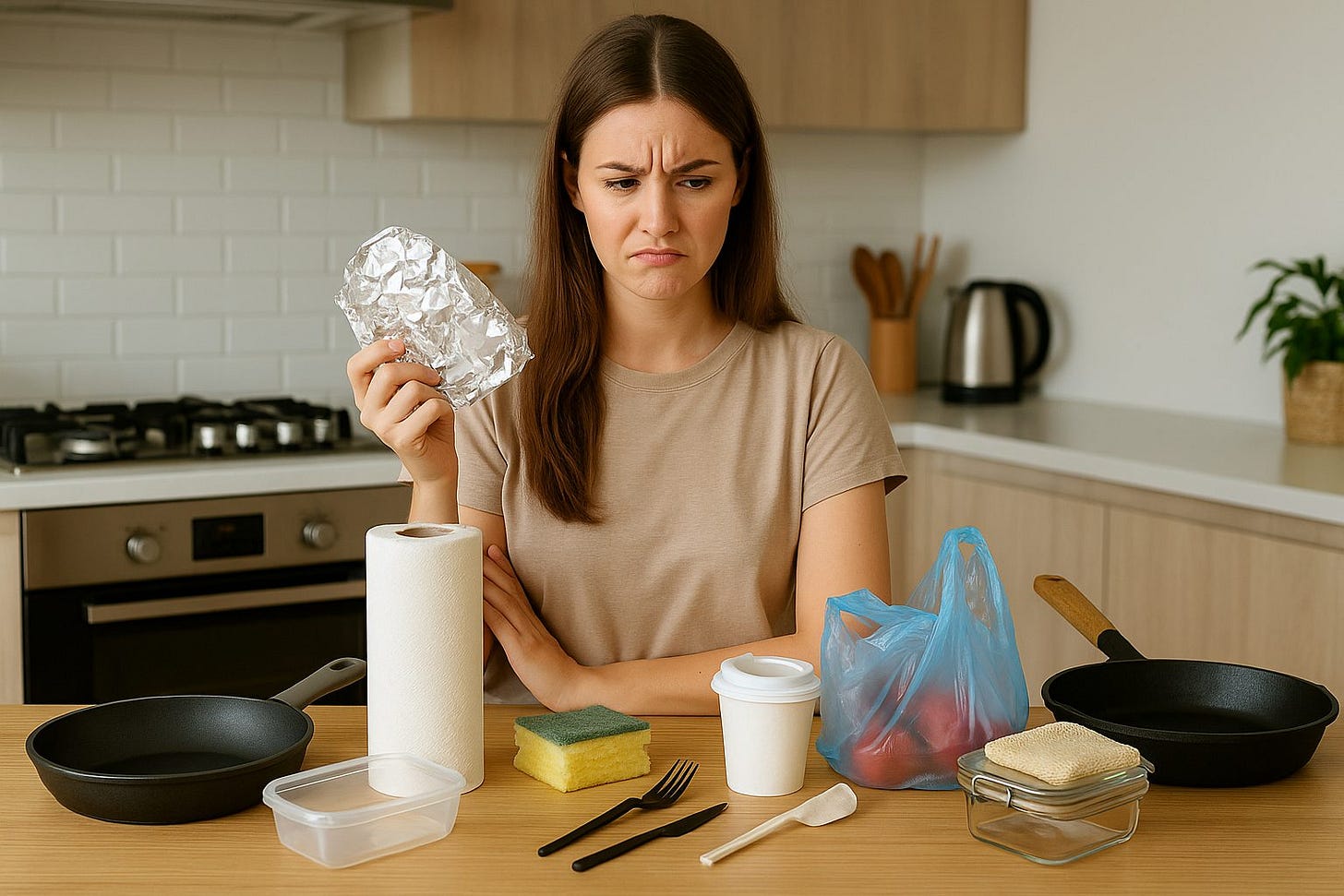7 Things in Your Kitchen That Are Wrecking the Environment (and What to Use Instead)
Dirty little secrets hiding in your drawers… and what you can swap to be part of the solution.
You stroll into your kitchen, humming along to your morning routine—coffee brewing, toast popping, life humming. But what if I told you that some of those seemingly innocent tools are quietly trashing the planet? Yep. Your trusty non-stick pan, that stack of plastic containers, even your cling wrap might be doing more harm than you think—leaching toxins, muddying waterways, and sticking around for centuries.
That's why I'm here: to guide you, like a cool insider with eco-geek cred. I think you'll feel empowered, not guilty—because small changes add up, fast. Let's pull back the curtain and see what your kitchen is up to… and what you can do instead. Ready? Let's go. 🌿
1. Non-Stick Cookware (PFAS Nest)
Non-stick pans seem like magic—until you remember the invisible chemicals they release. PFAS—those "forever chemicals"—linger in the environment and even our bodies, linked to serious health issues including insulin resistance.
Experts now urge using cast iron, carbon steel, or stainless steel instead. They heat beautifully and, bonus: they can last lifetimes.
Research shows PFAS in cookware raise type‑2 diabetes risk and never fully go away in the environment. Swap to smart metals and ditch the chemical haze.
2. Plastic Storage Containers & Utensils
Microwaving your leftovers in plastic? That's a chemical handshake you don't want. BPA, phthalates, microplastics—they're all potential guests in your dinner. Glass or stainless‑steel containers are smarter, cleaner, and worry‑free. And if you're using plastic utensils… especially black ones—stop.
Some of those are made from recycled electronics and packed with flame retardants. Scary. Choose wood, stainless, or ceramic instead.
3. Single-Use Plastic Wrap, Bags & Paper Towels
Cling‑wrap and zip bags are convenience at a tremendous cost—nearly forever in landfills or ocean gyres. Single-use paper towels? Just as wasteful.
Better: beeswax wraps, silicone bags, or just glass with lids—stylish, sustainable, and endlessly reusable. Swedish dishcloths or cloth towels? Even better.
Related: The Busy Parent's Guide to a Plastic-Free Lunchbox (That Kids Will Actually Eat)
4. Aluminum Foil (especially with acidic foods)
I know what you're thinking—it's just foil. But heated or acidic scraps can leach aluminum into your food, potentially worsening neurological concerns over time. Smoke swirl with a side of Alzheimer's risk—not what you had in mind. Safest bets? Stainless steel, ceramic, or even parchment paper (reusable or compostable versions exist).
5. Gas Stoves (The Unseen Polluters)
That sizzle and flame? Also billions of invisible pollutants—nitrogen dioxide, benzene—even in "clean-burning" models. In poorly ventilated kitchens, that's a respiratory risk. Switching to induction or electric (paired with ventilation) is not just energy-smart—it's breathing-smart.
6. Microfiber Towels & Disposable Sponges
They soak up mess—while shredding microplastics straight into your sink. Those tiny fibers drift into rivers, then lunch—and bonus: they irritate your eyes and lungs too. Opt for cellulose, cotton, bamboo, or coconut‑fiber sponges, or Swedish dishcloths. No more sneak attacks.
7. Single-Use Coffee Pods & Take-Out Cutlery
One coffee run. Two minutes of use. A landfill legacy that lasts centuries. Sure, paper cups seem eco-friendly—but most end up in landfills anyway. Instead: refillable pods, reusable coffee filters, your own mug. And bring your own utensils—simple, stylish, and planet-approved.
Why Bother? Because Every Little Swap Matters
These aren't dramatic makeovers. They're flavorful seasoning—small tweaks that taste good and feel good. Replace that clingwrap, step up to cast iron, disconnect from gas. Slowly, reliably, beautifully. The planet doesn't need perfect; it just needs better. Your kitchen sets the tone. Might as well make it proud.
Also read: 6 Eco-Friendly Kitchen Swaps That Actually Work (and Don't Suck)
A Final Nudge
Think of this as eco‑VIP mode—your kitchen, upgraded. I bet you might try one change this week—perhaps swapping plastic wraps or trying induction? Let me know which swap you're considering—and I'll help you geek out sourcing or styling it. You've got this.
Menu, eco‑style: activated.


